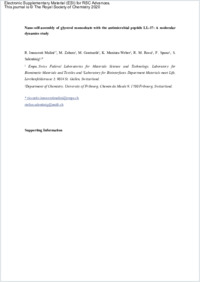Self-assembly of glycerol monooleate with the antimicrobial peptide LL-37: a molecular dynamics study
- Innocenti Malini, R. Empa, Swiss Federal Laboratories for Materials Science and Technology - Laboratory for Biomimetic Membranes and Textiles - 9014 St. Gallen - Switzerland
- Zabara, M. Laboratory for Biointerfaces - Department Materials meet Life - 9014 St. Gallen - Switzerland
- Gontsarik, M. Laboratory for Biointerfaces - Department Materials meet Life - 9014 St. Gallen - Switzerland
- Maniura-Weber, K. Laboratory for Biointerfaces - Department Materials meet Life - 9014 St. Gallen - Switzerland
- Rossi, R. M. Empa, Swiss Federal Laboratories for Materials Science and Technology - Laboratory for Biomimetic Membranes and Textiles - 9014 St. Gallen - Switzerland
- Spano, F. Empa, Swiss Federal Laboratories for Materials Science and Technology - Laboratory for Biomimetic Membranes and Textiles - 9014 St. Gallen - Switzerland
- Salentinig, Stefan Laboratory for Biointerfaces - Department Materials meet Life - 9014 St. Gallen - Switzerland - Department of Chemistry / Department of Chemistry, University of Fribourg, Chemin du Musée 9, 1700 Fribourg, Switzerland
-
2020
Published in:
- RSC Advances. - 2020, vol. 10, no. 14, p. 8291–8302
English
Over the past decade, the rapid increase in the incidence of antibiotic-resistant bacteria has promoted research towards alternative therapeutics such as antimicrobial peptides (AMPs), but their biodegradability limits their application. Encapsulation into nanocarriers based on the self-assembly of surfactant-like lipids is emerging as a promising strategy for the improvement of AMPs' stability and their protection against degradation when in biological media. An in-depth understanding of the interactions between the structure-forming lipids and AMPs is required for the design of nanocarriers. This in silico study, demonstrates the self-assembly of the amphiphilic lipid glycerol monooleate (GMO) with the antimicrobial peptide LL-37 into nanocarriers on the molecular scale. Molecular dynamics (MD) simulations show the formation of direct micelles, with either one or two interacting LL-37, and vesicles in this two- component system in agreement with experimental results from small-angle X- ray scattering studies. The hydrophobic contacts between LL-37 and GMOs in water appear responsible for the formation of these nanoparticles. The results also suggest that the enhanced antimicrobial efficiency of LL-37 in these nanocarriers that was previously observed experimentally can be explained by the availability of its side chains with charged amino acids, an increase of the electrostatic interaction and a decrease of the peptide's conformational entropy upon interacting with GMO. The results of this study contribute to the fundamental understanding of lipid–AMP interactions and may guide the comprehensive design of lipid-based self-assembled nanocarriers for antimicrobial peptides.
- Faculty
- Faculté des sciences et de médecine
- Department
- Département de Chimie
- Language
-
- English
- Classification
- Chemistry
- License
-
License undefined
- Identifiers
-
- RERO DOC 328420
- DOI 10.1039/C9RA10037G
- Persistent URL
- https://folia.unifr.ch/unifr/documents/308628
Other files
Statistics
Document views: 105
File downloads:
- pdf: 237
- Supplementary material: 145

